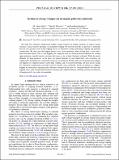Files in this item
Incoherent charge transport in an organic polariton condensate
Item metadata
| dc.contributor.author | Zeb, M. Ahsan | |
| dc.contributor.author | Kirton, Peter G. | |
| dc.contributor.author | Keeling, Jonathan | |
| dc.date.accessioned | 2022-11-07T12:30:13Z | |
| dc.date.available | 2022-11-07T12:30:13Z | |
| dc.date.issued | 2022-11-15 | |
| dc.identifier | 281862717 | |
| dc.identifier | fea68051-0755-47ba-9bb3-8262d318b022 | |
| dc.identifier | 85141921124 | |
| dc.identifier | 000884992400001 | |
| dc.identifier.citation | Zeb , M A , Kirton , P G & Keeling , J 2022 , ' Incoherent charge transport in an organic polariton condensate ' , Physical Review B , vol. 106 , no. 19 , 195109 . https://doi.org/10.1103/PhysRevB.106.195109 | en |
| dc.identifier.issn | 2469-9950 | |
| dc.identifier.other | ArXiv: http://arxiv.org/abs/2004.09790v2 | |
| dc.identifier.other | ORCID: /0000-0002-4283-552X/work/122720265 | |
| dc.identifier.uri | https://hdl.handle.net/10023/26313 | |
| dc.description | Funding: The authors acknowledge financial support from EPSRC program “Hybrid Polaritonics” (EP/M025330/1) and an ESQ fellowship of the Austrian Academy of Sciences (ÖAW) (PK). | en |
| dc.description.abstract | We study how polariton condensation modifies charge transport in organic materials. In typical organic materials, charge transport proceeds via incoherent hopping. We therefore provide an approach to determine how the rate and final state of this hopping process is affected by strong matter-light coupling and polariton condensation. We show how the hopping process may create excitations when starting from a state with a finite excitation density. That is, how hopping can change the state of a lower polariton condensate by creating upper polaritons, optically inactive excitonic dark states, or by exciting vibrational sidebands. While the matrix elements for these processes can be large, for typical materials at room temperature, such excitations are suppressed by thermal factors, and ground state processes dominate. We thus study how the ground state hopping rate depends on condensate density, matter-light coupling, and cavity photon detuning. All these factors change the vibrational configuration associated with the optically active molecules, which can enhance or suppress hopping by increasing or decreasing the vibrational overlap with the state of a charged molecule. We show that hopping rates can be exponentially sensitive to detuning and condensate density, allowing an increase or decrease of hopping rate by two orders of magnitude. | |
| dc.format.extent | 18 | |
| dc.format.extent | 850560 | |
| dc.language.iso | eng | |
| dc.relation.ispartof | Physical Review B | en |
| dc.subject | QC Physics | en |
| dc.subject | TK Electrical engineering. Electronics Nuclear engineering | en |
| dc.subject | NDAS | en |
| dc.subject | MCC | en |
| dc.subject | NCAD | en |
| dc.subject.lcc | QC | en |
| dc.subject.lcc | TK | en |
| dc.title | Incoherent charge transport in an organic polariton condensate | en |
| dc.type | Journal article | en |
| dc.contributor.sponsor | EPSRC | en |
| dc.contributor.institution | University of St Andrews. School of Physics and Astronomy | en |
| dc.contributor.institution | University of St Andrews. Centre for Designer Quantum Materials | en |
| dc.contributor.institution | University of St Andrews. Condensed Matter Physics | en |
| dc.identifier.doi | 10.1103/PhysRevB.106.195109 | |
| dc.description.status | Peer reviewed | en |
| dc.identifier.grantnumber | EP/M025330/1 | en |
This item appears in the following Collection(s)
Items in the St Andrews Research Repository are protected by copyright, with all rights reserved, unless otherwise indicated.

